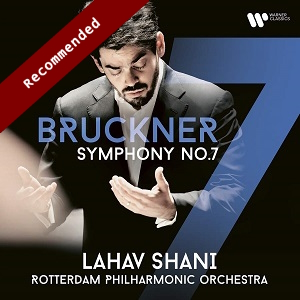
Anton Bruckner (1824-1896)
Symphony No 7 in E major, WAB 107 (1885 version, ed. Nowak)
Rotterdam Philharmonic Orchestra/Lahav Shani
rec. 2022, De Doelen, Rotterdam, Netherlands
Warner Classics 5419761966 [63]
I have of late, when reviewing a new recording of a Bruckner symphony, increasingly found myself asking the awkward and possibly provocative question, “Do we ‘need’ another recording?” We already have a myriad fine recordings by “old school” conductors such as Karajan, Giulini, Eichhorn, Sanderling and, more recently, equally excellent accounts from Schaller, Nelsons, Ballot and, in particular, a superb live recording from Bernard Haitink (review), made in Salzburg a couple of years before his death. How is it possible for any new, young conductor, no matter how gifted, to find something else to say or even match the work of names such as that? Obviously it is one thing to conduct a fine live performance and attendees might like a souvenir of such an occasion, but to record it for posterity and a wider market is a different proposition, yet the stream of recordings continues unabated and I wonder how many are sold and who is buying them.
That is not to disparage or discourage new recordings but the core repertoire is now surely saturated. Nonetheless, I try to approach each new issue free of prejudice and am almost invariably captivated by any halfway decent performance of such magnificent music – and this one is certainly a great deal better than that. There is a sense of natural, organic flow to this account which I find most engaging and I must account it as being among the most desirable I have heard.
Right from the yearning opening “dream motif”, the depth, richness and sonority of the orchestral playing are striking – and there is a breadth to Shani’s direction which infuses the phrasing with just the requisite majesty – moderately paced yet never stilted. He starts almost carefully but his plan is to gradually ratchet up tension through the development section and the slightly bass-heavy sound creates a kind of aural halo – but the third, “jumpy”, octave -based theme first introduced five and half minutes in and reintroduced halfway through, is suitably perky and animated – there is nothing leaden or lethargic about it. The central (Lord of the Rings!) climax is sublime and contrasts beautifully with the brooding, shimmering string passage which ensues and I must include a special word of praise for the brass section in the coda, which is phenomenal.
I must assume that the resonant acoustic of the De Doelen concert hall makes a major contribution to the success of this recording; all kinds of detail emerge triumphantly, such as the long, gradual timpani crescendo leading into the brass coda of the first movement. The four Wagner tubas, in particular, make such an imposing impact in the opening of the Adagio; their veiled, but burnished, sound adds immeasurably to the funereal solemnity of Bruckner’s lament for his fallen hero, Wagner. The Moderato section four minutes in flows inexorably towards the cymbal crash at 16:45, always gaining in tension, then in the coda the tubas conclude with the rising minor third elegy derived from the Te Deum to cap the movement with a wonderfully noble and profound melancholy.
The Scherzo is very emphatic and driven, underlining its earthy, rustic nature, and Shani applies a lot of rubato to the Trio, rendering it dreamy, almost sleepy, as if it were like the Adagio molto “dolcissimo Sonno” siesta interlude in “Autumn” from Vivaldi’s The Four Seasons. The brief finale is also rhythmically strong and has a suitably menacing edge to its succession of mercurial, alternately celebratory and minatory ideas; we constantly weave in and out of light and shade, tramping from “broad, sunlit uplands” into murky, tangled forests and once again the brass are notably glorious, eventually leading us into the triumphant blaze of the peroration.
This is a grand, majestic performance catching all the requisite light and shade of Bruckner’s most popular and accessible symphony.
Ralph Moore
(This review reproduced her by kind permission of The Bruckner Journal.)
Help us financially by purchasing from



















